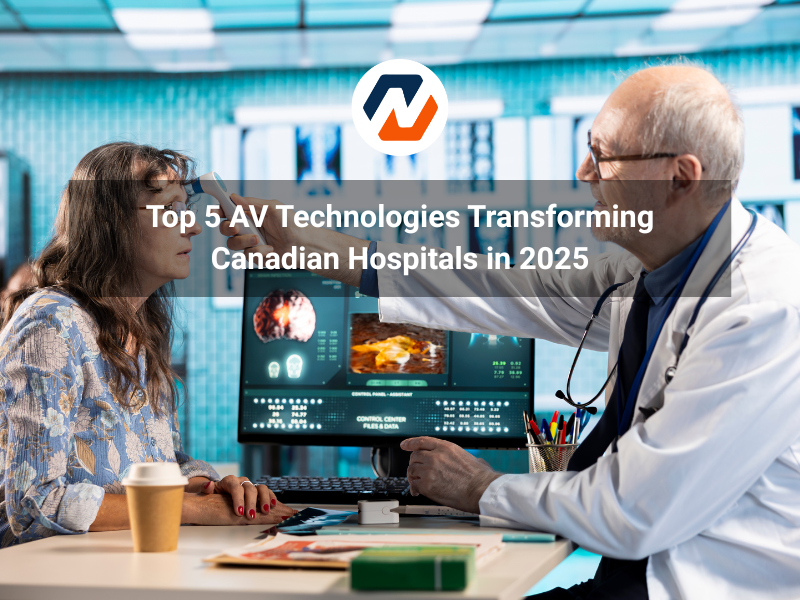admin2025-10-04T15:04:08+00:00
Table of Contents
ToggleIntroduction
Healthcare collaboration is evolving rapidly in Canada. From telehealth consultations to surgical team briefings, hospitals depend on advanced audio-visual (AV) systems to deliver faster diagnoses, reduce errors, and improve patient outcomes.
According to the Canadian Medical Association Journal (CMAJ, 2025), hospitals that invested in modern telehealth-ready AV rooms improved patient consult efficiency by 42%. Similarly, StatsCan reports that healthcare institutions adopting advanced AV reduced inter-site travel by 33%—saving both time and resources.
Here are the Top 5 AV technologies transforming Canadian hospitals in 2025
1. Telehealth-Enabled Conference Rooms
Why It Matters
Telehealth is no longer optional—it’s a core healthcare service. Conference rooms with dual displays allow physicians to view patient video on one screen and medical records on the other, while ceiling microphones ensure clear, hygienic communication.
Canadian Impact
Toronto hospitals that deployed telehealth-enabled rooms reported a 38% reduction in interdepartment travel and faster access to specialists.
✅ Best For: patient consultations, cross-site medical discussions.
2. Beamforming Ceiling Microphones
Why It Matters
In healthcare, hygiene is critical. Touchless beamforming ceiling microphones capture every voice in the room while eliminating the need for shared tabletop mics.
Canadian Impact
-
Ontario hospitals using ceiling microphones reported 42% faster telehealth consults, as conversations flowed naturally without audio dropouts.
✅ Best For: case review rooms, MDT (multidisciplinary team) meetings.
3. Dual-Display Setups for Case Reviews
Why It Matters
Doctors and specialists often need to view patient charts, scans, and live consultations simultaneously. Dual displays ensure data and people share equal visibility.
Canadian Impact
A Vancouver hospital improved case review efficiency by 29% after installing dual-display systems in their meeting spaces.
✅ Best For: surgical briefings, diagnostic consultations.
4. Interactive Smartboards for Training
Why It Matters
Medical training demands clarity and collaboration. Smartboards allow doctors to annotate on medical scans in real-time, while sessions can be recorded for e-learning and continuing education.
Canadian Impact
McGill University’s medical faculty reported a 37% boost in student engagement after adopting interactive smartboards in hybrid lecture halls.
✅ Best For: teaching hospitals, training centers, surgical simulations.
5. Secure & Compliance-Ready AV
Why It Matters
Healthcare AV must meet PIPEDA (Canada) and HIPAA (US) standards for privacy. Secure, encrypted video conferencing and compliance-ready recording tools protect patient confidentiality.
Canadian Impact
Hospitals adopting encrypted AV reduced compliance risk incidents by 31% (Deloitte Healthcare Risk Report, 2025).
✅ Best For: administrative boardrooms, compliance audits, telehealth.
Bonus Trend: AI-Powered Cameras in Surgery & Training
Hospitals are beginning to deploy AI cameras with auto-framing in surgical theaters and training rooms, ensuring clear, automated recording of complex procedures for future reference and teaching.
Conclusion
In 2025, Canadian hospitals are investing in modern AV solutions not just to improve communication, but to enhance patient care and medical training.
The top healthcare AV investments are:
-
Telehealth-enabled conference rooms
-
Beamforming ceiling microphones
-
Dual-display setups for case reviews
-
Interactive smartboards for training
-
Compliance-ready, secure AV systems
Together, these technologies are helping hospitals achieve:
-
42% faster consultations (CMAJ, 2025)
-
33% less inter-site travel (StatsCan, 2025)
-
31% reduced compliance risks (Deloitte, 2025)

